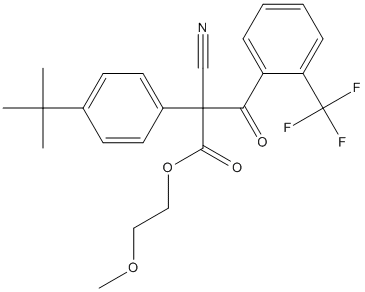Cyflumetofen
General
Type : Acaricide || Cyanide || Propionate || Not A\/B H target
Chemical_Nomenclature : 2-methoxyethyl 2-(4-~{tert}-butylphenyl)-2-cyano-3-oxo-3-[2-(trifluoromethyl)phenyl]propanoate
Canonical SMILES : CC(C)(C)C1=CC=C(C=C1)C(C#N)(C(=O)C2=CC=CC=C2C(F)(F)F)C(=O)OCCOC
InChI : InChI=1S\/C24H24F3NO4\/c1-22(2,3)16-9-11-17(12-10-16)23(15-28,21(30)32-14-13-31-4)20(29)18-7-5-6-8-19(18)24(25,26)27\/h5-12H,13-14H2,1-4H3
InChIKey : AWSZRJQNBMEZOI-UHFFFAOYSA-N
Other name(s) : SCHEMBL27174, CHEMBL2268728, DTXSID8058089, CHEBI:81798, CHEBI:136837

Target
Families : Cholinesterase-like
References (5)
| Title : The dynamic changes of genes revealed that persistently overexpressed genes drive the evolution of cyflumetofen resistance in Tetranychus cinnabarinus - Feng_2023_Insect.Sci_30_1129 |
| Author(s) : Feng K , Liu J , Zhao M , Jiang Z , Liu P , Wei P , Dou W , He L |
| Ref : Insect Sci , 30 :1129 , 2023 |
| Abstract : Feng_2023_Insect.Sci_30_1129 |
| ESTHER : Feng_2023_Insect.Sci_30_1129 |
| PubMedSearch : Feng_2023_Insect.Sci_30_1129 |
| PubMedID: 36380571 |
| Gene_locus related to this paper: tetur-t1jsk0 , tetur-t1l0m8 |
| Title : Downregulation of carboxylesterase contributes to cyflumetofen resistance in Tetranychus cinnabarinus (Boisduval) - Wei_2019_Pest.Manag.Sci_75_2166 |
| Author(s) : Wei P , Chen M , Nan C , Feng K , Shen G , Cheng J , He L |
| Ref : Pest Manag Sci , 75 :2166 , 2019 |
| Abstract : Wei_2019_Pest.Manag.Sci_75_2166 |
| ESTHER : Wei_2019_Pest.Manag.Sci_75_2166 |
| PubMedSearch : Wei_2019_Pest.Manag.Sci_75_2166 |
| PubMedID: 30653811 |
| Gene_locus related to this paper: tetur-t1kth5 , tetur-t1kx09 , tetur-t1ju32 , tetur-t1jth6 |
| Title : Functional Analysis of Esterase TCE2 Gene from Tetranychus cinnabarinus (Boisduval) involved in Acaricide Resistance - Shi_2016_Sci.Rep_6_18646 |
| Author(s) : Shi L , Wei P , Wang X , Shen G , Zhang J , Xiao W , Xu Z , Xu Q , He L |
| Ref : Sci Rep , 6 :18646 , 2016 |
| Abstract : Shi_2016_Sci.Rep_6_18646 |
| ESTHER : Shi_2016_Sci.Rep_6_18646 |
| PubMedSearch : Shi_2016_Sci.Rep_6_18646 |
| PubMedID: 26725309 |
| Gene_locus related to this paper: 9acar-q5s1p7 , tetur-t1kx09 |
| Title : Characteristics of carboxylesterase genes and their expression-level between acaricide-susceptible and resistant Tetranychus cinnabarinus (Boisduval) - Wei_2016_Pestic.Biochem.Physiol_131_87 |
| Author(s) : Wei P , Shi L , Shen G , Xu Z , Liu J , Pan Y , He L |
| Ref : Pestic Biochem Physiol , 131 :87 , 2016 |
| Abstract : Wei_2016_Pestic.Biochem.Physiol_131_87 |
| ESTHER : Wei_2016_Pestic.Biochem.Physiol_131_87 |
| PubMedSearch : Wei_2016_Pestic.Biochem.Physiol_131_87 |
| PubMedID: 27265830 |
| Gene_locus related to this paper: tetur-t1jth5 , tetur-t1kth5 , tetur-t1kwe1 , tetur-t1kx09 , tetur-t1kxr8 , tetur-t1l430 , tetur-t1kgp1 , tetur-t1l0m8 , tetur-t1knw0 , tetur-t1kgp7 , tetur-t1l013 , tetur-t1jz51 , tetur-t1kg31 , tetur-t1knv9 , tetur-t1jrz3 , tetur-t1k786 , tetur-t1jth6 , tetur-t1jtg9 , tetur-t1kpg7 , tetur-t1jvb8 , tetur-t1kvj7 |
| Title : Resistance selection and biochemical mechanism of resistance against cyflumetofen in Tetranychus cinnabarinus (Boisduval) - Wang_2014_Pestic.Biochem.Physiol_111_24 |
| Author(s) : Wang Y , Zhao S , Shi L , Xu Z , He L |
| Ref : Pestic Biochem Physiol , 111 :24 , 2014 |
| Abstract : Wang_2014_Pestic.Biochem.Physiol_111_24 |
| ESTHER : Wang_2014_Pestic.Biochem.Physiol_111_24 |
| PubMedSearch : Wang_2014_Pestic.Biochem.Physiol_111_24 |
| PubMedID: 24861930 |